Hello Friends and happy Friday! Get ready for this super yummy and healthy snack. It’s crisp, fresh, tangy, garlicky with a hint of hot pepper. I highly recommend making these Pickled Skinny Asparagus Snacks. So, don’t forget to add these to your list of weekend must-dos.
This recipe is inspired by the produce section overflowing with asparagus, my love for pickled foods and having healthy snacks on hand. I pickle this using the lacto-fermentation method by placing the asparagus in a salt brine with spices and letting it ferment on the counter for 5-7 days. I used the skinny asparagus for this recipe, but you can use the fat ones too. The skinny asparagus are more tender and crisp.
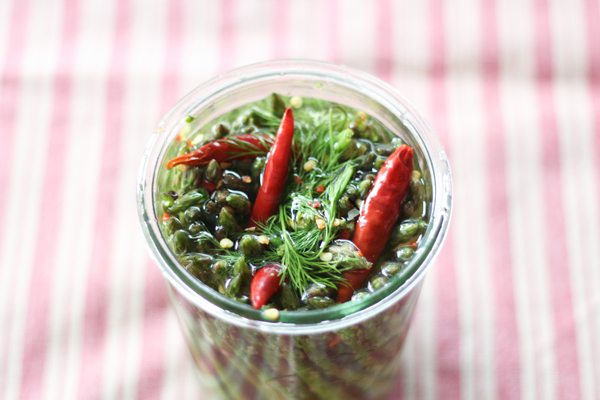
Not only are pickled skinny asparagus snacks fresh and delicious, they have many health benefits too. Some include:
- Probiotic and full of fiber, making them great for digestion. So if you suffer from acid reflux, tummy aches and are constipated or have diarrhea, these foods can help ease your symptoms.
- Fermented foods help your body absorb vitamins and minerals more efficiently. If your digestion is poor, you are unable to absorb the nutrients you are eating which leads to many health problems. Fermented foods are “pre-digested” and help break down food more efficiently.
- Energy! As a result of being able to absorb nutrients more efficiently and less energy being used by your body to digest, you will have an increase in energy.
- Asparagus is a great source of Vitamin B6, calcium, zinc and magnesium.
- An article, from Medical News Today stated that…
Eating asparagus can help control diabetes, act as a diuretic, prevent kidney stones, and reduce the risk of neural tube defects in babies.
So many benefits maybe they should be called Pickled Super Food Energy Sticks instead?
What you will need
Making pickles using this method is straight forward and requuires no fancy equipment. You will need a quart sized jar or similar, spices, purified water and high quality sea salt.
What to expect
For the first few days the brine will be clear and the asparagus bright. About 3 days into fermentation the brine will get cloudy. This is a good thing. It means the lactic-acid bacteria are doing their job.
Once the brine is cloudy after 3-5 days, try one. It should taste sour and be crunchy. If they are not sour or are too crunchy, leave them out another day or two and try one again. Once they are to your liking place them in the fridge. They are ready to eat! They will smell like pickle heaven and be tender and crisp when ready.
- 1 quart size mason jar or any jar of similar size
- 1 bunch of skinny asparagus
- Pickling Spices:
- 3 cloves garlic, rough chopped
- 1 tsp whole peppercorns
- 2 dried bay leaves
- 2 fresh dill fronds
- 4 dried Thai or Japanese chilis
- 1 tsp red chili flakes
- Salt Water Brine:
- 2½ cups water
- 2¼ tsp sea salt
- 1 tbsp raw apple cider vinegar or raw pineapple vinegar
- Soak the asparagus in ice water for 20 minutes to make them very crisp.
- Trim asparagus to fit the jar.
- Add asparagus to jar making sure the spears are sticking straight up.
- Add all the pickling spices to the jar (garlic, peppercorns, bay leaves, dill, dried chilis & chili flakes).
- To make the salt water brine: Add sea salt and ½ cup of warm water to a bowl.
- Stir until salt has dissolved.
- Add the remaining 2 cups of water to the bowl. Wait until the water has cooled to room temperature. If it is cool to touch add the apple cider vinegar.
- Pour brine into the jar with the asparagus. There should be enough to submerge the asparagus under the brine. If not, make more brine and add to jar.
- Cover the jar loosely with a lid or cotton cloth secured with a rubber band. Store in a cool place away from direct sunlight for 5-7 days.
- Once the brine is cloudy, take an asparagus out and taste it. If it smells like pickle heaven and tastes pickly too, they are ready. Store in the fridge. Otherwise leave them out to ferment longer and try them again in a day or two.
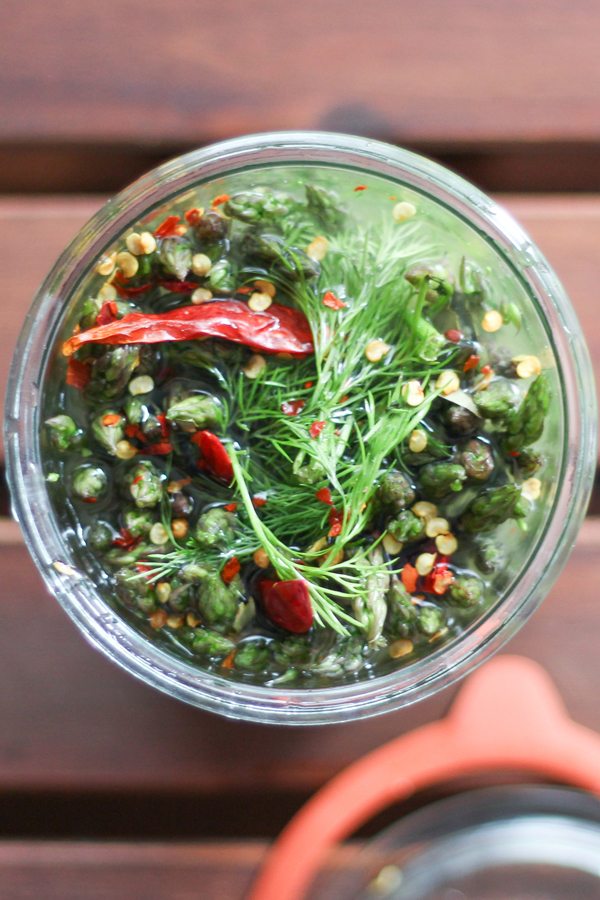
Resources & Articles
[optinlock id=”3″][/optinlock]
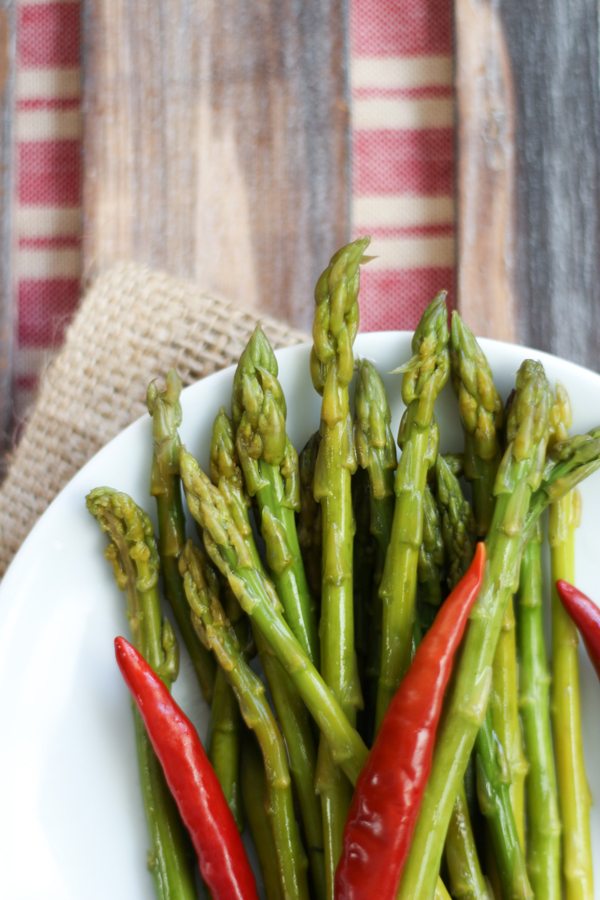
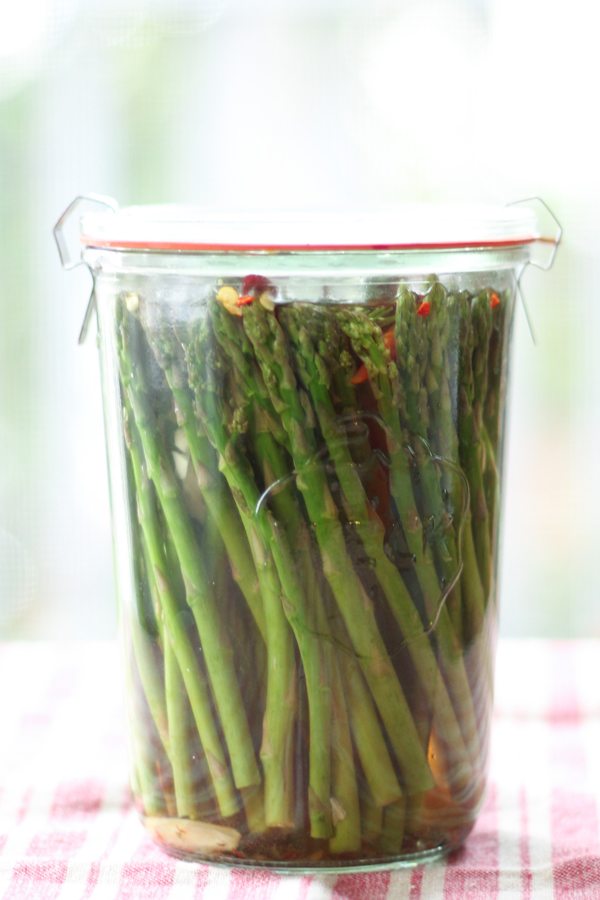
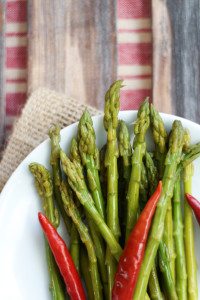
Love these pickled asparagus so much that I included them in my recipe roundup – 14 Asparagus Recipes to Celebrate Spring today! Check it out! http://holleygrainger.com/ways-to-make-asparagus/
Thank you Holley!
Hey there, Danielle,
I am so happy to have found you and your lovely blog! You’ve done an incredible job!
I am in love with fermented foods and I find your recipes so refreshing and unique <3 Thank you for sharing
I am stopping by the store tonight before I head home for the fresh dill and Thai Chili! I am so excited to make this!
Love,
Tiffany Kamp
Hi Tiffany, Thank you! Let me know how it turns out and if you have any questions along the way. Have a great day :)
I am not sure about adding vinegar as it inhibits LABs. http://www.pickl-it.com/faq/264/raw-vinegar-in-brine/
Hi Greg! Thanks for sharing. Adding the ACV is optional. I’ve been using this brine and love the results so I have continued to use it for most of my pickles.
I am sure they taste good. Just pointing out that this kills the “probiotic” benefit you are looking for. Alternatively, you could dip the asparagus in a little vinegar or add before eating. I’d just make this clear to readers and with the publication of the book Brain Maker, people will be looking for this recipe. We wouldn’t want to mislead them. Stated another way, not adding ACV is mandatory if you hope to produce probiotic food. Here is one more link on the topic: http://www.thehealthyhomeeconomist.com/the-crucial-difference-between-pickled-and-fermented/
I use very little ACV and every time I’ve had a very active brine. My veggies always get super bubbly and cloudy.
The article you reference is referring to vegetables that are heat processed with vinegar to pickle them- what we find on the grocery store shelves. It’s true, these are not probiotic, heat has been used to kill bad (and good) bacteria. While vinegar is a different type of fermentation, raw vinegar does have some similar bacterias. This recipe calls for raw apple cider vinegar, which is also a probiotic food. The small amount used will not “disrupt” ratios, inhibit LABs, change the type of fermentation, or kill the probiotic benefit. In fact, a small amount of acid from raw vinegar can help to inhibit bad bacteria growth, allowing for good bacteria to flourish. I love the idea and I think, I’ll give it a try in some of my fermentations. Great recipes and website! Thank you!